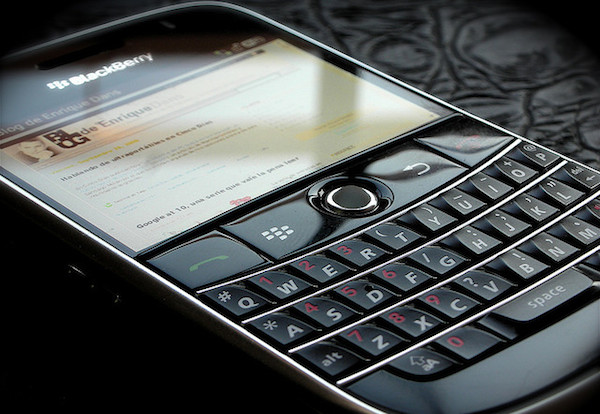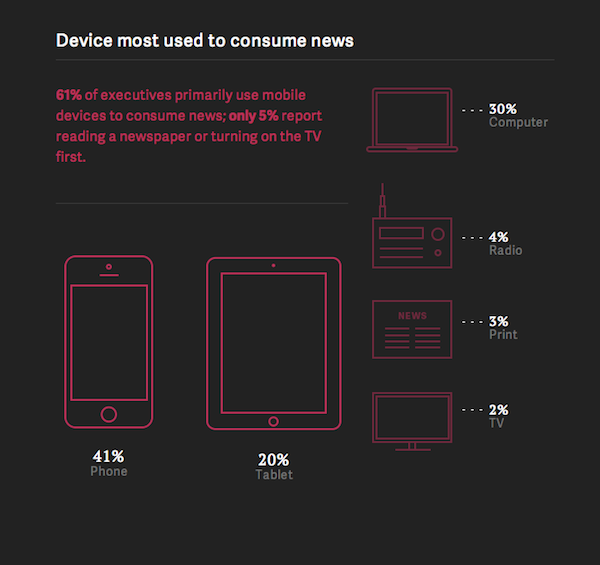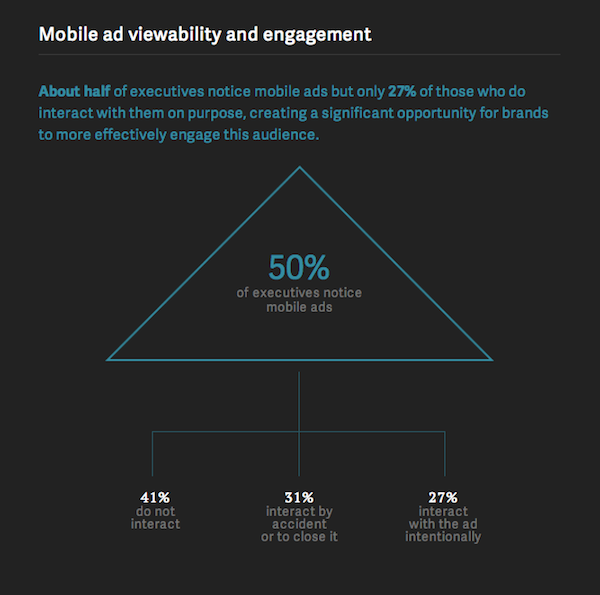
Do you work in a handsome corner office, one with a view? If so, you likely get a lot of your news in your inbox.
Of course, that’s true for many non-captains of industry too. But a new survey from Quartz looks specifically at the news habits of business executives and finds them — despite widespread adoption of mobile devices, with their panoply of apps and streams — still tethered to an old Internet classic. Sixty percent said that an email newsletter is one of the first three sources they turn to in the mornings for news — far ahead of dedicated news apps, social networks like Twitter, or news sites on mobile or desktop.
When keeping up on industry news, 56 percent say an email newsletter is a primary source — edging out both industry news sites and general news sites for the top spot. And when it comes time to share the news they’ve found, email (80 percent) topped Twitter (43 percent), Facebook (30 percent), and LinkedIn (30 percent) as their platform of choice.

The survey from Quartz, produced by its marketing team, provides an interesting peek into a specific demographic — and, it should probably be noted, lines up well with what Quartz is already doing. (The 940 executives surveyed were “sourced from the Quartz audience and via partner channels,” the report says, perhaps marking them as already friendly to the Quartz way of doing things.) It also found that mobile devices, especially phones, were a big driver of executives’ attention: 61 percent say the device they use most to get news is a mobile one — 41 percent phones, 20 percent tablets.
“The fact that they are willing to consume and share, that was a great validation that if we do provide interesting, relevant, useful content, even the most time-starved audience could use it,” said Quartz publisher Jay Lauf.
Lauf said the data from the survey can be used to help both the business and editorial sides of Quartz become more effective in reaching their audience. On the advertising side, Lauf said the results support the news web’s recent push into sponsored content. Executives were asked to think of the last digital ad they could remember. The survey found that video ads are highly memorable to executives: 54 percent cited a video ad as the last digital ad they could recall. The second most remembered ad format to executives: sponsored content, with 28 percent. A regular ol’ banner ad? Only 12 percent.
Quartz editor-in-chief Kevin Delaney said the survey’s data on mobile and social consumption habits back up the ideas that helped start Quartz. Two years ago when the site launched, building something designed first for smaller screens and distribution through social media invited some skepticism, he said. “It definitely deepens our conviction on the use of mobile, sharing, and email newsletters by global business executives,” Delaney said.
Delaney told me Quartz’s daily briefing email now has 75,000 subscribers and a daily open rate of 40 to 50 percent. The research will be used to help make improvements throughout the site, Delaney said. Because their mobile readership is so strong, they recently improved the zooming functionality for charts on mobile devices, he said.The survey of business executives — including C-level executives, vice presidents, managing partners, managing directors, and other positions making more than your friendly neighborhood hyperlocal blogger — took place in March and included fields like finance, technology, media, healthcare, and management consulting. More than 50 percent of the survey responses were completed on a mobile device.
Mia Mabanta, head of strategic products at Quartz who oversaw the survey, previously worked on similar projects for Pew and the Brookings Institution. She said audience research is increasingly important for media companies that want to innovate and stay relevant, which is why Quartz will likely make this survey an annual undertaking. “What it represents is Quartz’s ambition to truly understand its audience, the global executive, who they are, what their habits are, and how best to engage them,” Mabanta said.
Here’s a rundown of some of the findings:

Three-quarters of executives spend at least 30 minutes a day consuming the news, with 44 percent saying the time right after waking up as the period they’re most focused on news — far ahead of any other time of day. (Thirty percent said they checked throughout the day, without a single most focused time.) When broken down by industry, executives in the media business — surprise! — were the most dedicated to news, with 80 percent spending 30 minutes or more and 41 percent over an hour.
While mobile devices are the leading way executives get their news, 30 percent told Quartz a traditional computer as their primary news-consuming device. Only 3 percent cited print as their top source, and just 2 percent cited television.

Reading news these days is almost synonymous with sharing news, and that holds true for executives: 91 percent said they would share work-related news with others. The devices they use most often to share is split almost evenly: 47 percent for mobile, 48 percent for desktop.
Even people in the corner office have to pay for news: 61 percent said they subscribe to newspapers and magazines, but only 3 percent said print is their primary news source. (For media executives, those numbers jump only slightly: 64 percent subscribe, 4 percent say it’s their primary news source.) Just over a third, 37 percent, of executives pay for digital news. Of those, people in finance are most likely to pay at 47 percent, while only 40 percent of media executives said they pay for digital news.

This might not be surprising given the audience, but 86 percent of executives told Quartz they are interested in seeing more branded content. The C-suite might be the perfect audience for those messages: 55 percent of respondents said they follow brands in their own industry on social media, and 47 percent said they follow brands outside of their line of work. (Those numbers jump to 73 percent and 64 percent, respectively, for the media industry.)
When it comes to the device for ads, 58 percent of executives said desktop ads were more memorable, while 42 percent said mobile ads are memorable.